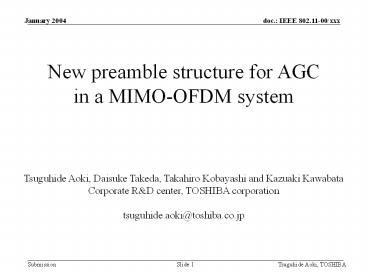New preamble structure for AGC in a MIMO-OFDM system - PowerPoint PPT Presentation
Title:
New preamble structure for AGC in a MIMO-OFDM system
Description:
New preamble structure for AGC in a MIMO-OFDM system Tsuguhide Aoki, Daisuke Takeda, Takahiro Kobayashi and Kazuaki Kawabata Corporate R&D center, TOSHIBA corporation – PowerPoint PPT presentation
Number of Views:68
Avg rating:3.0/5.0
Title: New preamble structure for AGC in a MIMO-OFDM system
1
New preamble structure for AGC in a MIMO-OFDM
system
- Tsuguhide Aoki, Daisuke Takeda, Takahiro
Kobayashi and Kazuaki Kawabata - Corporate RD center, TOSHIBA corporation
- tsuguhide.aoki_at_toshiba.co.jp
2
Main scope of TGn
- Achieve 100Mbps measured at MAC SAP (PAR FR)
- ?MIMO-OFDM is one of the possible candidates.
- Some of the modes shall be backwards compatible
and interoperable with 802.11a and/or 802.11g
(PAR FR) - Backward compatibility between legacy 11a and
MIMO-OFDM is one of the main issues. - Preamble structure of 11a should be maintained
- in a MIMO-OFDM system.
- Alternatively, use protection mechanisms as
defined in 11g (RTS-CTS, CTS self)
3
Example of preamble structure for MIMO system
Same as 11a ?Backward compatibility
Channel estimation for MIMO signals
TX1
DATA
GI
LP
GI
LP
GI
LP
SP
Sig
Sig 2
GI
LP
TX2
DATA
GI
LP
GI
LP
GI
-LP
GI
-LP
TX3
DATA
GI
LP
GI
-LP
GI
-LP
GI
LP
Indicate 11n preamble structure
TX4
GI
LP
DATA
GI
-LP
Similar structure is presented in 03/714r0
- AGC for Tx1 could be performed by using SP
transmitted during the legacy period. - It is difficult to adjust the gain control for
Tx2-Tx4 during MIMO signals because of the
insufficient information for other antennas. - ?This causes a severe saturation or
quantification error in ADC.
4
New preamble structure with 2nd SPs for MIMO
system
1st AGC
2nd AGC
TX1
DATA
GI
LP
GI
LP
SP
Sig
2nd SP
GI
LP
GI
LP
Sig2
TX2
DATA
2nd SP
GI
LP
GI
LP
GI
-LP
GI
-LP
TX3
2nd SP
GI
LP
GI
-LP
GI
-LP
GI
LP
DATA
TX4
2nd SP
DATA
GI
LP
GI
-LP
GI
LP
GI
-LP
2nd SP for MIMO-AGC
- The 1st AGC for Tx 1 could be performed by using
legacy SP. - The 2nd AGC for MIMO signals could be performed
by using the 2nd SPs. - The 2nd SP with same sequence for Tx1-Tx4 causes
a Null (beamforming) effect. - --gtDifferent sequence should be used for the 2nd
SP on each antenna.
5
Simulated transmit signals with 2nd SP
Total transmission power is always the same.
f
Tx 1
f
Tx 2
f
Tx 3
f
Tx 4
Base-band transmit signals (In-phase)
Tx 1 transmits same sequence of legacy SP.
6
Simulated receive signals with 2nd SP
Target gain for the selected antenna is used for
all RF/IF chains.
Select an antenna with maximum power.
2nd SP
1st SP
Rx 1
Rx 2
Rx 3
Rx 4
2nd AGC
1st AGC
Base-band transmit signals (In-phase)
7
Distribution of the received power for data part
and 1st /2nd SP part in channel model C(NLOS)
Tx3, Rx3
Normalized received power for data
Saturation
Quantization error
Normalized received power of SP (conventional
preamble)
This figure shows the power of antenna with
maximum power in SP(2nd SP)
8
Simulation parameters
Architecture IEEE802.11a-based MIMO-OFDM
Antenna element ULA (half a wavelength)
Modulation and coding scheme 54Mbps(64QAM, R3/4)
Channel model TGn Channel model (03/940)
IF/RF impairment Ignored
Synchronization (Timing sync. Frequency sync.) Ideal
Channel estimation Ideal
MIMO detection algorithms MMSE-BLAST(MMSE-based OSIC)
DATA length 1000 Bytes for each stream
ADC 10bit-ADC
AGC Common gain AGC (power measurement is ideal)
9
BER/PER performance vs. average amplitude of SP
in channel model B(NLOS)
PSDU1000bytes for each,10bit-ADC
10
BER/PER performance vs. average amplitude of SP
in channel model C(NLOS)
PSDU1000bytes for each,10bit-ADC
11
BER/PER performance vs. average amplitude of SP
in channel model D(NLOS)
PSDU1000bytes x 3,10bit-ADC
12
BER/PER performance vs. average amplitude of SP
in channel model E(NLOS)
PSDU1000bytes x 3,10bit-ADC
13
Conclusions
- A new preamble structure with 2nd SP was
examined. - Dynamic range of AGC is large compared with
conventional preamble. - BER /PER performance can be improved.
- Our preamble structure is effective to improve
the performance of MIMO systems.































